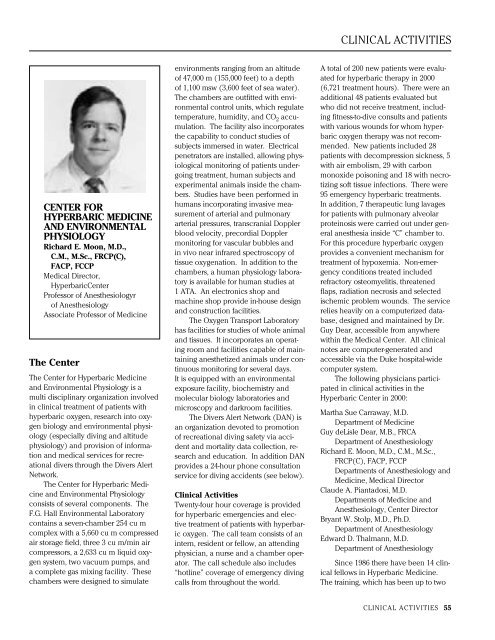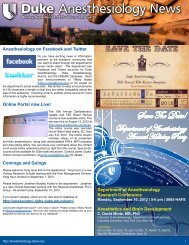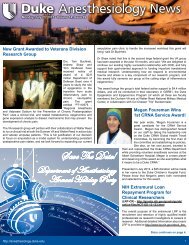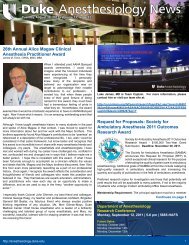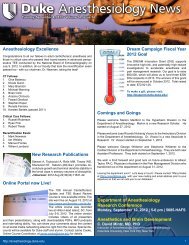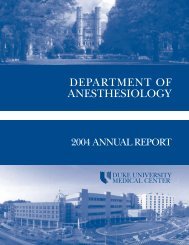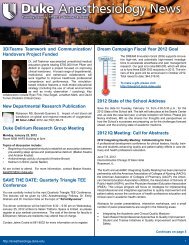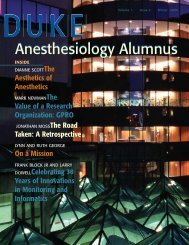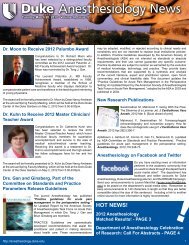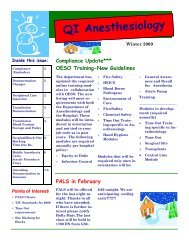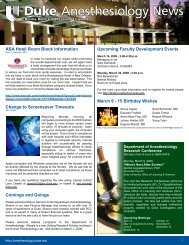DEPARTMENT OF ANESTHESIOLOGY ANNUAL REPORT
DEPARTMENT OF ANESTHESIOLOGY ANNUAL REPORT
DEPARTMENT OF ANESTHESIOLOGY ANNUAL REPORT
Create successful ePaper yourself
Turn your PDF publications into a flip-book with our unique Google optimized e-Paper software.
CENTER FOR<br />
HYPERBARIC MEDICINE<br />
AND ENVIRONMENTAL<br />
PHYSIOLOGY<br />
Richard E. Moon, M.D.,<br />
C.M., M.Sc., FRCP(C),<br />
FACP, FCCP<br />
Medical Director,<br />
HyperbaricCenter<br />
Professor of Anesthesiologyr<br />
of Anesthesiology<br />
Associate Professor of Medicine<br />
The Center<br />
The Center for Hyperbaric Medicine<br />
and Environmental Physiology is a<br />
multi disciplinary organization involved<br />
in clinical treatment of patients with<br />
hyperbaric oxygen, research into oxygen<br />
biology and environmental physiology<br />
(especially diving and altitude<br />
physiology) and provision of information<br />
and medical services for recreational<br />
divers through the Divers Alert<br />
Network.<br />
The Center for Hyperbaric Medicine<br />
and Environmental Physiology<br />
consists of several components. The<br />
F.G. Hall Environmental Laboratory<br />
contains a seven-chamber 254 cu m<br />
complex with a 5,660 cu m compressed<br />
air storage field, three 3 cu m/min air<br />
compressors, a 2,633 cu m liquid oxygen<br />
system, two vacuum pumps, and<br />
a complete gas mixing facility. These<br />
chambers were designed to simulate<br />
environments ranging from an altitude<br />
of 47,000 m (155,000 feet) to a depth<br />
of 1,100 msw (3,600 feet of sea water).<br />
The chambers are outfitted with environmental<br />
control units, which regulate<br />
temperature, humidity, and CO 2 accumulation.<br />
The facility also incorporates<br />
the capability to conduct studies of<br />
subjects immersed in water. Electrical<br />
penetrators are installed, allowing physiological<br />
monitoring of patients undergoing<br />
treatment, human subjects and<br />
experimental animals inside the chambers.<br />
Studies have been performed in<br />
humans incorporating invasive measurement<br />
of arterial and pulmonary<br />
arterial pressures, transcranial Doppler<br />
blood velocity, precordial Doppler<br />
monitoring for vascular bubbles and<br />
in vivo near infrared spectroscopy of<br />
tissue oxygenation. In addition to the<br />
chambers, a human physiology laboratory<br />
is available for human studies at<br />
1 ATA. An electronics shop and<br />
machine shop provide in-house design<br />
and construction facilities.<br />
The Oxygen Transport Laboratory<br />
has facilities for studies of whole animal<br />
and tissues. It incorporates an operating<br />
room and facilities capable of maintaining<br />
anesthetized animals under continuous<br />
monitoring for several days.<br />
It is equipped with an environmental<br />
exposure facility, biochemistry and<br />
molecular biology laboratories and<br />
microscopy and darkroom facilities.<br />
The Divers Alert Network (DAN) is<br />
an organization devoted to promotion<br />
of recreational diving safety via accident<br />
and mortality data collection, research<br />
and education. In addition DAN<br />
provides a 24-hour phone consultation<br />
service for diving accidents (see below).<br />
Clinical Activities<br />
Twenty-four hour coverage is provided<br />
for hyperbaric emergencies and elective<br />
treatment of patients with hyperbaric<br />
oxygen. The call team consists of an<br />
intern, resident or fellow, an attending<br />
physician, a nurse and a chamber operator.<br />
The call schedule also includes<br />
“hotline” coverage of emergency diving<br />
calls from throughout the world.<br />
CLINICAL ACTIVITIES<br />
A total of 200 new patients were evaluated<br />
for hyperbaric therapy in 2000<br />
(6,721 treatment hours). There were an<br />
additional 48 patients evaluated but<br />
who did not receive treatment, including<br />
fitness-to-dive consults and patients<br />
with various wounds for whom hyperbaric<br />
oxygen therapy was not recommended.<br />
New patients included 28<br />
patients with decompression sickness, 5<br />
with air embolism, 29 with carbon<br />
monoxide poisoning and 18 with necrotizing<br />
soft tissue infections. There were<br />
95 emergency hyperbaric treatments.<br />
In addition, 7 therapeutic lung lavages<br />
for patients with pulmonary alveolar<br />
proteinosis were carried out under general<br />
anesthesia inside “C” chamber to.<br />
For this procedure hyperbaric oxygen<br />
provides a convenient mechanism for<br />
treatment of hypoxemia. Non-emergency<br />
conditions treated included<br />
refractory osteomyelitis, threatened<br />
flaps, radiation necrosis and selected<br />
ischemic problem wounds. The service<br />
relies heavily on a computerized database,<br />
designed and maintained by Dr.<br />
Guy Dear, accessible from anywhere<br />
within the Medical Center. All clinical<br />
notes are computer-generated and<br />
accessible via the Duke hospital-wide<br />
computer system.<br />
The following physicians participated<br />
in clinical activities in the<br />
Hyperbaric Center in 2000:<br />
Martha Sue Carraway, M.D.<br />
Department of Medicine<br />
Guy deLisle Dear, M.B., FRCA<br />
Department of Anesthesiology<br />
Richard E. Moon, M.D., C.M., M.Sc.,<br />
FRCP(C), FACP, FCCP<br />
Departments of Anesthesiology and<br />
Medicine, Medical Director<br />
Claude A. Piantadosi, M.D.<br />
Departments of Medicine and<br />
Anesthesiology, Center Director<br />
Bryant W. Stolp, M.D., Ph.D.<br />
Department of Anesthesiology<br />
Edward D. Thalmann, M.D.<br />
Department of Anesthesiology<br />
Since 1986 there have been 14 clinical<br />
fellows in Hyperbaric Medicine.<br />
The training, which has been up to two<br />
CLINICAL ACTIVITIES 55


